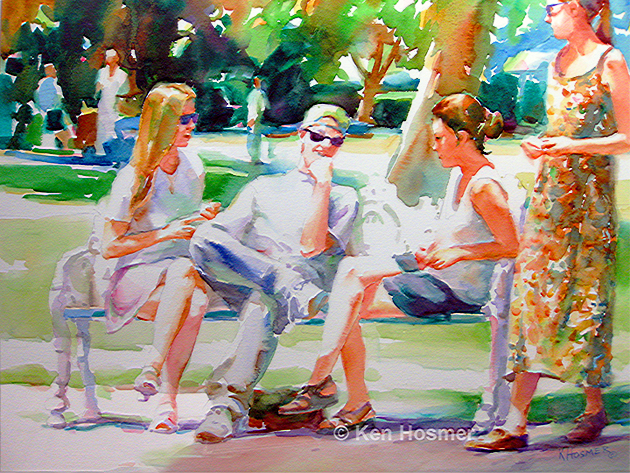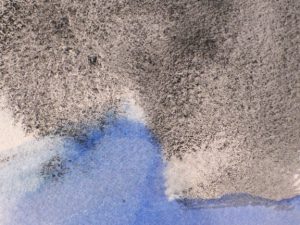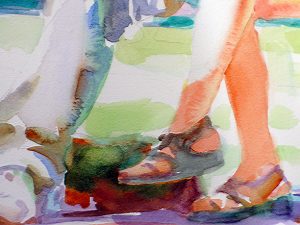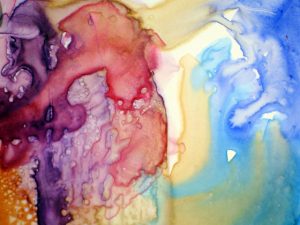
Find the Best Paper for Your Technique
There are many watercolor paper choices. So how do you find the right paper for your needs? In the following article, I present watercolor paper basics, the pros and cons of various papers, and suggestions based on personal experience.
Featured Painting:
'At the Park'—watercolor by Ken Hosmer
As you explore watercolor, it is helpful to understand the variables that cause one paper to perform differently than another.
Beware of student-grade papers.
Artist-grade or professional watercolor paper is traditionally sold as individual sheets, although there are now many more options. A standard full sheet is 22 x 30 inches. It is important to use professional-grade, 100% rag or cotton, acid free paper. This is a selling point, so if watercolor paper is one hundred percent cotton, it will say so on the label or internet product description.
Why is this so important? Non-cotton, student-grade papers often have three problematic characteristics: they don't allow the paint to flow and disburse properly; they are fragile and will tear or dissolve when removing or lifting paint to make corrections; they contain wood pulp which is acidic and will discolor the paper with age. Although some student-grade papers are now treated with calcium carbonate or other chemicals to neutralize acid, they still don't perform well compared to professional quality paper. Low-grade paper may save money; however, in my experience, many student paintings fail because of inferior paper—it is best to avoid this trap.
Match the paper to your technique.
If you paint with layered washes, then you want a sturdy paper with tooth and moderate sizing, so that a new wash does not disturb the previous layer. If your technique involves lifting paint, then you need a more heavily sized paper. If you plan to work outdoors, then you don't want to be encumbered by complicated stretching tools or buckling paper. The key is to select a paper that most easily facilitates your planned painting method.
Do you lift paint?
Some professional watercolor artists seldom lift or remove paint after it is dry, so this may not be an important factor in selecting a watercolor paper. However, in many modern watercolor techniques, lifting paint is common practice. In my own work I routinely soften hard edges by lifting with a brush of soft sponge. Also, workshop students can make a number of corrections by lifting. A paper with the ability to easily make such alterations is a great asset.
How watercolor paper behaves is largely determined by three basic qualities: sizing, texture, and weight.
Amount of Sizing
Watercolor papers are manufactured with a coating of gelatin, starch, or other synthetic material—referred to as sizing. Paper may be surface sized, internally sized, or a combination of both. The quality of sizing greatly influences the behavior of paint as it flows across the paper.
Lightly sized papers absorb more paint which tends to diffuse the brush strokes; after paint dries, it is harder to soften edges or lift corrective passages; these papers also tend to be more fragile. Heavily sized papers absorb less, so paint stays more on the paper surface; this tends to enhance both color and crisp paint texture; paint lifts more easily, so layered washes may be more difficult to apply.
Surface Texture
Watercolor paper is classified into three surface textures: rough (very textured), cold press (less textured), and hot press (smooth). Cold press paper is the most versatile and recommended in most workshops. It is more forgiving, as the texture acts to smooth uneven brushwork. Rough paper has a heavier texture or tooth which is useful for dry-brush techniques or to enhance paint granulation. Hot press paper has a smooth surface which shows off brush strokes, and natural paint flow. It will also create more surface bloom. See the photo examples for a better understanding of textural effects.


Paper Weight
Although there are variations, most watercolor paper is either 140 lb. (thinner) or 300 lb. (thicker). This indicates the weight of the paper measured in pounds per ream. Weight may also be designated in (gsm) grams per square meter.
I usually use 140 lb. paper in the studio, as lighter weight paper dries faster and is less expensive. I prefer 300 lb. paper when painting outdoors because the extra thickness prevents buckling and dries slower on a hot breezy day.
Popular Paper Brands
Arches
Cold press—the most popular paper used in workshops. It is ideal for paintings with multiple wash layers, now available in bright white for more vibrant colors, and very sturdy for lifting without paper damage. Because of widespread familiarity with this paper, I use it as a standard for comparison to other papers.
Hot press—very smooth, but lifting or correction is nearly impossible. The paper surface abrades easily if scrubbed.
Winsor and Newton
After being unavailable for a long time—Winsor and Newton paper is back!
Cold press—paper texture is slightly smoother than Arches cold press. This paper is heavily sized and quite white, making it good for vibrant color and easy softening of hard edges after paint dries; however, it lifts a bit easier than Arches, so for layered washes I recommend a soft brush. This paper is very sturdy for lifting without paper damage. The 140 lb. is one of my overall favorites.
Hot press—shows every brush stroke and is great for creating deliberate bloom texture. When stretching, I usually only wet this paper from the back to avoid removing sizing from the top surface. As with other hot press papers, when handling paper watch out for skin oils or hand lotion, as these can create resist spots.
Rough—the texture of this paper is similar to Arches cold press.

Stonehenge Aqua (added to blog 1-2020)
Manufactured in the U.S.A. and distributed by Legion Paper. (The paper does not have a watermark.)
Cold press—paper texture runs smoother than Arches cold press. This paper is heavily sized, has excellent paint dispersion, and is easy to lift or soften edges after the paint is dry. Because of the heavy sizing, glazing must be done very cautiously to avoid lifting the previous under layers. This excellent paper is similar in handling to Winsor and Newton.
Hot press—this is my favorite hot press. The paper is heavily sized and very sturdy. I was able to easily remove a section of paint with the Mr. Clean Magic Eraser sponge, and repaint the area.
Kilimanjaro
Produced by Cheap Joe's, this paper is currently only available in cold press, but has two versions: original bright white or natural white. This is a very versatile paper for workshops and behaves much like Arches. The paper has moderate sizing, and good paint flow. It is slightly more fragile than Aches or Winsor and Newton, so lifting should be done with a brush or soft sponge; do not attempt to remove paint with a toothbrush.
Fabriano
Fabriano Artistico is a very popular paper, however the cold press and hot press will abrade when rubbed with a soft sponge.
Lanaquarelle
The 140 lb. cold press sheet is a moderately sized, rather fragile paper. I don't use this paper, but it is very popular with a pleasing off white coloration.
Yupo
This smooth paper made of plastic, keeps the paint on the surface. It is great for special textural effects. Paint can be totally removed back to white paper, or a wash can be reflowed, landing in a new configuration.

Strathmore
I especially like several Strathmore specialty papers. (Note that 500 series in this brand denotes 100% cotton content.)
500 series, 4-ply plate Bristol—sold in individual sheets, this heavyweight bristol paper works great for watercolor. It behaves much like Yupo, but with a hot press paper finish. There is no need to pre-wet or stretch this paper, but attach it firmly, as the paper tends to curl. It is also available as a heavier illustration board.
Aquarius II –comes in a thinner 80lb sheet. This paper is a blend of natural and synthetic fibers, designed to lay flat with no buckling. It is great for mixed media and applying acrylic on top of watercolor.
In Summary
There always seems to be another new watercolor paper to try. So I suggest finding a readily available paper and sticking with it until you perfect your preferred technique. Then branch out and have fun by experimenting with new papers!
For more information:
Finding the Best Hot Press Paper
See Art Supply Links
